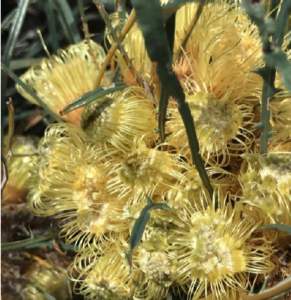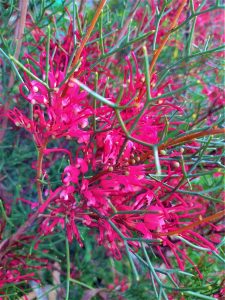Verna Aslin shares with us summaries of what’s going on in the ANPSA study groups between August – November 2022. Included in her summaries are email address contacts for each study group, for any enquiries you may have.
The ANPSA Study Group newsletters can be found here.
Dryandra SG newsletter, no. 83, July 2022

Dryandra cuneata is a species widespread in WA. It is also considered to be hardy when grown in the eastern state (drier areas)
Margaret Pieroni reports on group members’ field trips undertaken in April and May in the Lake King, WA area, with species and locations listed. It was noted that among the Dryandra populations visited, an early or late flowering individual may be identified, or one that differs in its morphology. In some cases they may be hybrids.
Dryandra Woodland, near Narrogin WA, is now a national park. Dryandra species that are found there are described. One is D. bipinnatifida var. bipinnatifida (pictured, photo Catriona Bate).
Study group contact is mpieroni@bigpond.com
Australian Food Plants SG, no.66, September 2022
No.66 is a “special WA edition” and describes a number of plants especially from the Kimberley region which have nutritional, medicinal or useful properties.
Beach bean, beach banana, dogs nuts, and crotalaria are among those mentioned.
Beach beans can be cooked and eaten but are toxic when raw, unfortunately for castaway mariners who attempted to survive by eating them.
The newsletter reports on the growth of a niche market for saltbush-fed lamb, saltbush being a valuable drought reserve for pastoralists.
Native or “wild” rice is described and its potential market discussed. The newsletter reminds study group members of a Bushfood Conference to be held on 27-28 May 2023 at ATAC, North MacLean, Queensland. Study group contact is australianfoodplants@gmail.com
Fern SG newsletter, no.152, September 2022
The Sydney regional group has a busy program of excursions underway, with a break in December/January. The SE Queensland regional group is planning an excursion south to Port Macquarie on 4-7 November, while reporting “fern feasts” on recent excursions on home territory. Study Group contact is ANPSAferns@bigpond.com
Eremophila SG newsletter, no.136, September 2022
The profile of Eremophilas has had a boost lately, with leader Lyndal Thorburn addressing the Biennial APS conference in mid-September, promotional items including Christmas cards being marketed, and great articles on Eremophila being published in regional journals.
A number of research projects are underway or due to start soon. It’s noted that E. racemosa is hard to find in nurseries, with the exception of the yellow-and-white version “Peaches and Cream”. On an excursion to Western Queensland, 14 species were found, including the beautiful E. goodwinii ssp. goodwinii. It was found growing in two locations near Cunnamulla, looking like a field of UK forest bluebells. Study Group contact is lthorburn@viria.com.au

Hakea SG newsletter, no.80, October 2022
The newsletter reports on a Hakea excursion in Western Australia, including the Mogumber, Lesueur National Park, and Eneabba areas.
40 species were observed including H. megalosperma and H. chromatropa, although some other rare species proved elusive.
Leader Paul Kennedy reports that his Hakea book is in progress (slowly!).
The newsletter includes remarks on tropical and subtropical hakeas in cultivation, and also central Australian hakeas, which prove slow growing in cooler and wetter climates. Study group contact is hakeaholic@gmail.com
